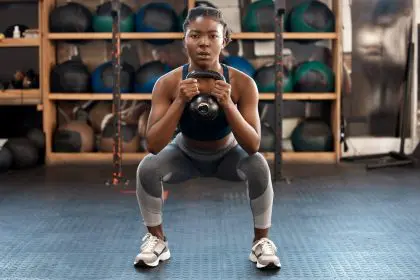The number on your weighing scale reflects a complex equation of calories consumed versus calories burned, but not all exercise approaches this equation effectively. While any movement burns calories, certain exercises create metabolic advantages that continue working long after you’ve showered and changed. This comprehensive guide explores 12 evidence-backed exercises that maximize fat loss through multiple mechanisms, creating sustainable results that transform both your scale reading and overall body composition.
1. Kettlebell swings build explosive power while scorching calories
The kettlebell swing combines explosive power development with cardiovascular demand, creating a metabolic storm that few other exercises can match. This dynamic movement engages the entire posterior chain—hamstrings, glutes, back, and shoulders—while simultaneously challenging your grip, core stability, and cardiovascular system.
What makes kettlebell swings particularly effective for fat loss is their ability to keep your heart rate elevated while building muscle tissue. Research shows that a 20-minute kettlebell workout can burn approximately 400 calories, but the benefits extend far beyond the session itself. The combination of strength and conditioning elements elevates post-exercise oxygen consumption, meaning your body continues burning additional calories for hours afterward.
For maximum fat-burning effect, try a simple protocol of 8 rounds of 20 seconds of all-out swings followed by 10 seconds of rest. Start with a weight that challenges you without compromising form—typically 35-53 pounds for men and 18-35 pounds for women with previous training experience. Focus on generating power from your hips rather than your arms, allowing the kettlebell to float momentarily at chest height before controlling its descent.
Regular kettlebell swing practice not only burns fat directly but also builds posterior chain strength that improves performance in other exercises, creating a compounding effect on your fat loss journey.
2. Burpees deliver full-body conditioning without equipment
Few exercises generate as much metabolic stress as the burpee, which explains both its effectiveness for fat loss and its reputation for difficulty. This equipment-free movement combines a squat, plank, push-up, and vertical jump into one fluid sequence that spikes heart rate while challenging multiple muscle groups simultaneously.
The full-body nature of burpees creates an oxygen debt that forces your body to work overtime during recovery, burning additional calories long after you’ve completed your workout. Research indicates that high-intensity exercises like burpees can increase your metabolic rate for up to 48 hours post-workout through a process called excess post-exercise oxygen consumption (EPOC).
For maximum fat-burning impact, incorporate burpees into interval protocols. Try 4-6 rounds of 30 seconds of maximum-effort burpees followed by 30 seconds of complete rest. This approach maximizes intensity while allowing sufficient recovery to maintain proper form throughout the workout.
Beginners can modify burpees by stepping back into the plank position rather than jumping, eliminating the push-up, or reducing the explosive jump at the top of the movement. These modifications maintain the metabolic benefits while building the necessary strength and conditioning for the full movement pattern.
3. Squats activate your largest muscle groups for maximum burn
Squats engage the body’s largest muscle groups—quadriceps, hamstrings, and glutes—creating a powerful metabolic effect that makes them essential for any fat loss program. The energy required to move and control your body weight through a full squat range of motion significantly elevates calorie expenditure during the exercise itself.
More importantly, the muscle-building stimulus from regular squatting increases your body’s basal metabolic rate, the number of calories burned at rest. Research indicates that every pound of muscle gained increases daily caloric expenditure by approximately 50 calories, making the strength-building aspect of squats crucial for long-term fat loss.
The squat pattern allows numerous variations to progressively challenge your body:
Bodyweight squats for beginners focusing on proper form Goblet squats adding upper body engagement and core stability Back squats for maximum lower body strength development Front squats emphasizing quadriceps and core development Jump squats adding explosive power and cardiovascular demand
For optimal fat loss results, combine heavier strength-focused squat sessions (4-5 sets of 5-8 repetitions with challenging resistance) with higher-repetition metabolic sessions (2-3 sets of 15-20 repetitions with moderate resistance). This dual approach maximizes both the immediate calorie burn and the longer-term metabolic advantages of increased muscle mass.
4. Rowing machine sprints combine upper and lower body power
The rowing machine delivers one of the most complete full-body workouts available, engaging approximately 86% of your muscles through a synchronized pattern of pushing with the legs and pulling with the upper body. This comprehensive muscle recruitment creates substantial energy demands that translate directly to caloric expenditure and fat loss potential.
What separates rowing from many other cardio options is its balanced muscle engagement pattern. While running and cycling primarily tax the lower body, rowing distributes work between the legs, core, back, and arms, creating more balanced development while maximizing calorie burn.
For fat loss purposes, interval sprints on the rower prove most effective. Try this progressive protocol:
5-minute easy warm-up at moderate pace 6 rounds of 250-meter sprints at maximum effort with 60-90 seconds rest between Gradually progress to 8-10 rounds as conditioning improves 5-minute cool-down at a relaxed pace
This approach generates significant cardiovascular strain while minimizing joint impact, making it suitable for most fitness levels and body types. The relative safety of rowing compared to high-impact exercises allows for more frequent training sessions, accelerating fat loss results through increased training volume.
Proper rowing technique—driving primarily with the legs, maintaining a strong core, and finishing with a controlled pull to the torso—maximizes both effectiveness and safety. Focus on power generation rather than rowing cadence for the greatest fat-burning effect.
5. Deadlifts build total-body strength that revs metabolism
The deadlift stands as perhaps the most comprehensive strength movement available, engaging nearly every major muscle group simultaneously while allowing substantial weight to be lifted. This combination creates powerful hormonal and metabolic responses that directly support fat loss efforts both during and after training.
Deadlifting heavy weights stimulates the release of growth hormone and testosterone, hormones that play crucial roles in muscle development and fat metabolism. This hormonal response creates an environment that favors muscle retention and fat utilization, particularly important during caloric deficits necessary for weight loss.
For maximum fat loss benefits, incorporate both conventional heavy deadlifts and higher-repetition variations:
Heavy conventional deadlifts (3-5 sets of 3-6 repetitions) for maximum strength stimulus Romanian deadlifts at moderate weights (3-4 sets of 8-12 repetitions) for posterior chain development Sumo deadlifts for inner thigh and adductor engagement Single-leg (staggered stance) deadlifts for balance and stabilizer development
Deadlifts require particular attention to proper form to maximize benefits while minimizing injury risk. Focus on maintaining a neutral spine position, initiating the movement by driving through the floor with your legs, and keeping the weight close to your body throughout the movement.
The significant muscle mass developed through regular deadlifting creates lasting metabolic advantages, as muscle tissue requires considerably more energy to maintain than fat tissue. This makes deadlifting an investment in your long-term metabolic health beyond immediate calorie burning.
6. Jump rope intervals maximize calorie burn in minimal time
The simple jump rope delivers remarkable fat-burning efficiency, with research showing it can burn more than 10 calories per minute while improving coordination, agility, and cardiovascular conditioning. This accessible tool provides workout options ranging from beginner-friendly to intensely challenging, making it adaptable to any fitness level.
Jump rope workouts excel at creating what exercise physiologists call “concurrent training effect”—simultaneously developing aerobic capacity, anaerobic power, and muscular endurance. This multifaceted training stimulus creates comprehensive fitness improvements that support fat loss through various pathways.
For optimal fat-burning results, structure jump rope sessions as progressive intervals:
Beginner protocol: 8 rounds of 20 seconds jumping followed by 40 seconds rest Intermediate protocol: 10 rounds of 30 seconds jumping followed by 30 seconds rest Advanced protocol: 12 rounds of 40 seconds jumping followed by 20 seconds rest
As technique and conditioning improve, incorporate advanced variations like double-unders, crossovers, or single-leg jumping to increase intensity without extending workout duration. These variations increase coordination demands while further elevating heart rate and caloric expenditure.
The minimal equipment requirements and space needs make jump rope workouts particularly valuable for maintaining consistency—a crucial factor in long-term fat loss success. A quality jump rope easily fits in a travel bag, allowing workouts to continue during business trips or vacations when other options might be limited.
7. Battle ropes challenge cardiovascular endurance and upper body power
Battle rope training has emerged as one of the most effective high-intensity interval training modalities, creating massive cardiovascular demand while building upper body and core strength. The combination of resistance and cardiovascular challenge creates a potent fat-burning stimulus that few other exercises can match.
Research examining battle rope intervals shows they can elevate heart rates to 85-90% of maximum while engaging multiple muscle groups, creating both immediate calorie expenditure and significant EPOC effect. A standard 10-minute battle rope interval session can burn approximately 120-250 calories, with additional calories expended during the extended recovery period.
For maximum fat loss benefits, structure battle rope workouts as timed intervals:
Basic protocol: 8 rounds of 30 seconds maximum effort followed by 30 seconds rest Advanced protocol: 10 rounds of 40 seconds work followed by 20 seconds rest
Alternate between different movement patterns to engage different muscle groups and prevent fatigue:
Alternating waves for shoulder endurance Double-arm slams for power development Lateral whips for rotational core strength Circles for shoulder stability and conditioning
The highly visual nature of battle rope training—seeing the wave patterns you create—provides immediate feedback and motivation, helping maintain intensity throughout challenging intervals. This psychological advantage supports the consistent high-intensity effort necessary for optimal fat-burning results.
8. Mountain climbers deliver cardio benefits in a strength-building position
Mountain climbers bridge the gap between cardiovascular training and strength development, creating a metabolic conditioning effect that directly supports fat loss goals. This dynamic movement elevates heart rate while simultaneously challenging core stability, hip mobility, and upper body endurance.
The plank position maintained throughout mountain climbers engages the entire core musculature isometrically while the alternating knee drives add dynamic lower body engagement. This combination creates substantial energy demands that translate directly to caloric expenditure, making mountain climbers a time-efficient fat-burning exercise.
For maximum effectiveness, incorporate mountain climbers into timed intervals rather than counting repetitions:
Beginner approach: 4 rounds of 20 seconds effort followed by 40 seconds rest Intermediate approach: 6 rounds of 30 seconds effort followed by 30 seconds rest Advanced approach: 8 rounds of 40 seconds effort followed by 20 seconds rest
Focus on maintaining proper plank position throughout the movement—shoulders stacked over wrists, body forming a straight line from head to heels, and core engaged to prevent lower back sagging. This attention to form maximizes core engagement while protecting the lower back from excessive stress.
Variations like cross-body mountain climbers (bringing knee toward opposite elbow) and slow-tempo mountain climbers (emphasizing control rather than speed) can be incorporated to target different muscle groups and prevent adaptation as fitness improves.
9. Thrusters combine squat and press for full-body fat burning
The thruster merges a front squat with an overhead press into one fluid movement, creating a comprehensive exercise that challenges both the lower and upper body simultaneously. This combination generates significant metabolic stress that directly supports fat loss through both acute calorie burning and muscle-building effects.
Research examining compound movements like thrusters shows they elevate heart rate more effectively than single-joint exercises while also creating greater hormonal responses favorable to both muscle development and fat mobilization. This hormonal environment supports body composition changes that extend beyond simple calorie mathematics.
For optimal fat-burning impact, thrusters can be programmed in several effective formats:
Strength-endurance protocol: 4 sets of 12-15 repetitions with moderate weight and 60-90 seconds rest Metabolic conditioning: 5 rounds of 30 seconds maximum repetitions followed by 30 seconds rest Density training: Set a 10-minute timer and complete as many quality repetitions as possible, resting as needed
Thrusters can be performed with various implements—barbells for maximum loading, dumbbells for greater range of motion, or kettlebells for grip variation. This adaptability allows progressive overload as strength develops while maintaining the exercise’s metabolic benefits.
The technical demands of thrusters—maintaining proper squat depth, core stability during transition, and safe overhead pressing—create additional athletic benefits beyond fat loss. These improved movement patterns transfer to daily activities, supporting long-term mobility and functionality.
10. Boxing combinations deliver stress relief with fat-burning intensity
Boxing training combines cardiovascular conditioning, rotational power development, and upper body endurance in a format that many find more engaging than traditional cardio approaches. This psychological advantage supports consistency—perhaps the most important factor in long-term fat loss success.
The combination of punching mechanics and constant footwork creates full-body engagement that elevates heart rate while building functional strength and coordination. Research shows that a 30-minute boxing session can burn between 300-400 calories while developing rotational core strength that traditional exercises often miss.
For maximum fat-burning effects without specialized equipment, try this shadow boxing interval protocol:
5-minute warm-up with basic footwork and single punches 8 rounds of 2 minutes high-intensity combinations followed by 30 seconds active recovery Focus on proper rotation, extension, and retraction of punches Include defensive movements like slips, ducks, and blocks between offensive combinations 5-minute cool-down with decreased intensity
Basic combinations like jab-cross-hook or jab-cross-duck-hook provide accessible starting points for beginners, while more advanced practitioners can create longer combination chains that further elevate intensity and coordination demands.
Beyond the direct caloric expenditure, boxing training often reduces stress hormone levels, potentially supporting fat loss through improved hormonal environments. The psychological release many experience during impact training creates additional benefits for overall wellbeing and adherence to fitness programs.
11. Weighted step-ups build lower body power while elevating heart rate
Step-ups represent one of the most functional movement patterns in any exercise program, directly transferring to daily activities like climbing stairs while creating substantial lower body strength and cardiovascular demand. This practical movement pattern can be progressively loaded to challenge even advanced trainees.
What makes weighted step-ups particularly effective for fat loss is their unilateral nature—each leg works independently, preventing stronger limbs from compensating for weaker ones. This balanced development ensures that all available muscle tissue contributes to both performance and metabolism.
For maximum fat-burning effect, try these step-up protocols:
Strength-focused approach: 3-4 sets of 8-10 repetitions per leg with challenging weights and full range of motion Endurance-focused approach: 3 sets of 15-20 repetitions per leg with moderate weight and minimal rest between sides Metabolic approach: Alternate 30 seconds of maximum repetitions on each leg for 6-8 total rounds
The height of the step directly influences both the difficulty and the muscle emphasis—lower steps focus more on quadriceps while higher steps increase glute and hamstring recruitment. For most trainees, a height that creates approximately 90-degree knee angles at the bottom position provides optimal balance between safety and effectiveness.
Weighted step-ups can be performed with dumbbells held at the sides, a barbell across the upper back, or a single kettlebell in the goblet position. These loading variations change the stability demands and emphasis, allowing for continued progression as fitness improves.
12. Medicine ball slams release tension while building power and burning fat
Medicine ball slams merge strength development, power expression, and cardiovascular conditioning into a single movement that many find emotionally satisfying and physically challenging. The explosive nature of the exercise creates significant metabolic demands while building useful power that transfers to other athletic movements.
The full-body coordination required—from ground force production through core transmission to upper body expression—engages multiple muscle groups simultaneously, maximizing caloric expenditure during the exercise. The relatively low skill requirements allow beginners to achieve high-intensity effort quickly compared to more technical power exercises.
For optimal fat-burning results, structure medicine ball slams as timed intervals rather than fixed repetition schemes:
Basic protocol: 6 rounds of 30 seconds maximum effort followed by 30 seconds recovery Advanced protocol: 8 rounds of 40 seconds work followed by 20 seconds recovery
The weight of the medicine ball significantly impacts both the intensity and the safety of the exercise. Most women find 8-14 pound balls appropriate, while most men work effectively with 14-20 pound options. The ball should be heavy enough to create resistance but not so heavy that speed and power diminish significantly.
Medicine ball slams offer valuable psychological benefits alongside their physical effects. The primal nature of forcefully projecting an object downward provides stress relief that many find lacking in more controlled exercises. This emotional release can support program adherence while potentially reducing stress hormones that interfere with fat loss.
These 12 exercises create fat loss results through multiple complementary mechanisms—immediate calorie expenditure, extended metabolic elevation post-workout, muscle development that increases basal metabolism, and improved hormonal environments that favor fat utilization. While each exercise provides benefits individually, structuring them into comprehensive programs delivers synergistic effects that transform both the number on your scale and your overall body composition.
For maximum effectiveness, combine these exercises into workouts that blend strength-focused movements with metabolic conditioning, creating the ideal stimulus for both muscle preservation and fat utilization. Consistent application of these principles, alongside appropriate nutrition, delivers the sustainable results that truly change your relationship with your weighing scale.


















